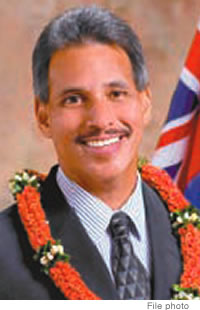A Good Idea Better Late Than Never

Wednesday - February 03, 2010
| Share
 Del.icio.us
Del.icio.us
|
It’s not often that state government wades into the murky waters of athletics with any plan more advanced than attaching itself to a popular topic in the hopes of garnering positive publicity.
Such was the case in 2007, when embattled University of Hawaii athletic director Herman Frazier was called before an uninterested board to testify about the crumbling state of his department.
Lt. Gov. Duke Aiona’s plan to create a state sports commission to bring in new revenue streams for the state is a good one, despite stumbling on a major issue involving facilities.
More on that faux pas later.
The LG’s plan to market the state as a destination for everything from mixed martial arts to AYSO soccer and golf is a sound, if late, idea. Amateur athletics is a colossal business, and youth leagues are in constant search of locations to test their mettle against opponents common and otherwise.
It’s also a great excuse for businesses and municipalities to prosper from the fundraising efforts of Little Leaguers everywhere.
In 1987, Minnesota created a similar organization that, according to its Web site, attracted 4.75 million attendees and generated an out-of-state economic impact totaling $67.5 million in 2006 alone. A year ago, Indianapolis hosted a high school girls’ volleyball tournament that included 6,000 competitors who pumped an estimated $14 million into the local economy.
Disney created its sports facilities, later renamed the ESPN Wide World of Sports Complex, as a way to tap into this huge market, and since its inception in 1997 it has played host to just about every sport one can imagine, and has generated millions for the corporation.
Because of Hawaii’s geography and high cost of living, which increases the cost for every business, resident and visitor, and is the reason why Taco Bell’s 85-cent, five-layer burrito costs $1.49, the commission won’t be able to generate the amount of revenue enjoyed by Mainland sites.
But even a slice of a multibillion-dollar industry is an improvement. It also is unlikely the state will be able to maintain its commitment without contributions from either the general fund or a yet-to-be created special fund.
Minnesota’s final facilities bill came to slightly more than $49 million from 1987 to 2000, with a return on its investment of nearly $377 million.
Aiona’s plan is to support the committee with $100,000 from a special fund, with further contributions coming from private donors and fees associated with the events. While it is not inconceivable the program could run as planned, fundraising has never been easy in this state.
And facilities maintenance, which is key to attracting the needed number of participants, is a long-term cost the organization is not likely to be able to fund - especially when the sites to be used fall under the jurisdiction of state, county and the University of Hawaii.
This is where Aiona’s announcement suddenly hit a rough spot.
During the press conference last week, he rattled off the names of the available sites on Oahu, such as the Patsy Mink Regional Park, Stan Sheriff Center and the Duke Kahanamoku Aquatic Complex, along with various locations on the Neighbor Islands. The one curiously missing site, especially when the announcement was admittedly scheduled to coincide with the absence of the Pro Bowl, was Aloha Stadium, which is in need of considerable repairs.
“To be honest, when I was talking about facilities, I wasn’t thinking about Aloha Stadium,” said the LG when queried about funds being available for repairs on the 34-year-old stadium.
He then quickly began doing the Capitol two-step, saying he thinks the stadium will take care of itself, that money has been appropriated for repairs and that future plans for the stadium will be discussed in the future, when the future becomes the present and past problems become current concerns.
Whatever new events the commission is able to attract, its first targets have to be sports that have succeeded despite government indifference. The Pro Bowl will have to wait. And after the disappointment that was the Miami game - the state suddenly is in a much better position to negotiate.
The Honolulu Marathon and Hawaii’s golf industry have flourished even though the state has virtually ignored them. In fact, it may be the reason for their success.
In the four years prior to 2009, the marathon generated more than $100 million in revenue for the state each year. It is likely to reach five straight when all the numbers come in for the 2009 event.
The state’s entire contribution to the marathon since its inception is zero.
Golf is a $1.4 billion industry in Hawaii that attracts players from around the world, yet any real support is nonexistent.
Why?
Because like the marathon, Hawaii’s golf courses are not going anywhere.
Take care of those two and they’ll take care of the state. Then they can go after the big cheerleading dollars.
E-mail this story | Print this page | Comments (0) | Archive | RSS Comments (0) |
Most Recent Comment(s):













